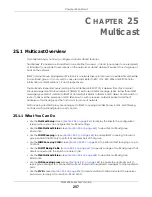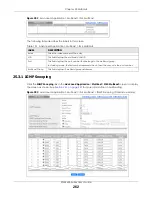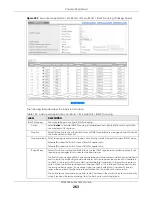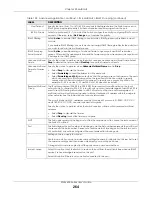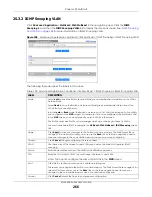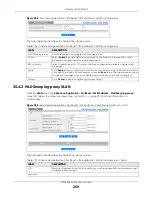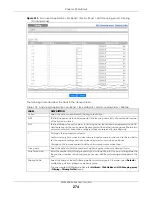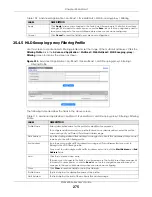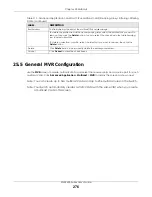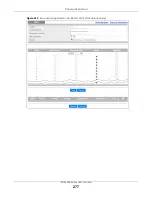
Chapter 25 Multicast
XGS4600 Series User’s Guide
270
Query Interval
Enter the amount of time (in miliseconds) between general query messages sent by the
router connected to the upstream port. This value should be exactly the same as what is
configured in the connected multicast router.
This value is used to calculate the amount of time an MLD snooping membership entry
(learned only on the upstream port) can remain in the forwarding table.
When an MLD Report message is received, the Switch sets the timeout period of the entry
to be T = (QI*RV) + MRD, where T = Timeout, QI = Query Interval, RV = Robustness Variable,
and MRD = Maximum Response Delay.
Maximum Response
Delay
Enter the amount of time (in miliseconds) the router connected to the upstream port waits
for a response to an MLD general query message. This value should be exactly the same
as what is configured in the connected multicast router.
This value is used to calculate the amount of time an MLD snooping membership entry
(learned only on the upstream port) can remain in the forwarding table.
When an MLD Report message is received, the Switch sets the timeout period of the entry
to be T = (QI*RV) + MRD, where T = Timeout, QI = Query Interval, RV = Robustness Variable,
and MRD = Maximum Response Delay.
When an MLD Done message is received, the Switch sets the entry’s lifetime to be the
product of
Last Member Query Interval
and
Robustness Variable
.
Robustness Variable
Enter the number of queries. A multicast address entry (learned only on an upstream port
by snooping) is removed from the forwarding table when there is no response to the
configured number of queries sent by the router connected to the upstream port. This
value should be exactly the same as what’s configured in the connected multicast
router.
This value is used to calculate the amount of time an MLD snooping membership entry
(learned only on the upstream port) can remain in the forwarding table.
Last Member Query
Interval
Enter the amount of time (in miliseconds) between the MLD group-specific queries sent by
an upstream port when an MLD Done message is received. This value should be exactly
the same as what’s configured in the connected multicast router.
This value is used to calculate the amount of time an MLD snooping membership entry
(learned only on the upstream port) can remain in the forwarding table after a Done
message is received.
When an MLD Done message is received, the Switch sets the entry’s lifetime to be the
product of
Last Member Query Interval
and
Robustness Variable
.
Downstream
Query Interval
Enter the amount of time (in miliseconds) between general query messages sent by the
downstream port.
Maximum Response
Delay
Enter the maximum time (in miliseconds) that the Switch waits for a response to a general
query message sent by the downstream port.
Add
Click this to create a new entry or to update an existing one.
This saves your changes to the Switch’s run-time memory. The Switch loses these changes
if it is turned off or loses power, so use the
Save
link on the top navigation panel to save
your changes to the non-volatile memory when you are done configuring.
Cancel
Click
Cancel
to reset the fields to your previous configuration.
Clear
Click
Clear
to reset the fields to the factory defaults.
Index
This is the index number of the MLD snooping-proxy VLAN entry in the table. Click on an
index number to view more details or change the settings.
VID
This field displays the ID number of the VLAN group.
Select an entry’s check box to select a specific entry. Otherwise, select the check box in
the table heading row to select all entries.
Table 107 Advanced Application > Multicast > IPv6 Multicast > MLD Snooping-proxy > VLAN
LABEL
DESCRIPTION
Содержание XGS4600 Series
Страница 24: ...24 PART I User s Guide ...
Страница 44: ...44 PART II Technical Reference ...
Страница 180: ...Chapter 13 Spanning Tree Protocol XGS4600 Series User s Guide 180 Figure 145 MSTP and Legacy RSTP Network Example ...
Страница 189: ...Chapter 16 Mirroring XGS4600 Series User s Guide 189 Figure 150 Advanced Application Mirroring Standalone Mode ...
Страница 244: ...Chapter 22 Policy Rule XGS4600 Series User s Guide 244 Figure 189 Policy Example EXAMPLE ...
Страница 277: ...Chapter 25 Multicast XGS4600 Series User s Guide 277 Figure 215 Advanced Application Multicast MVR Standalone Mode ...
Страница 559: ...Chapter 59 Access Control XGS4600 Series User s Guide 559 Figure 460 Example Lock Denoting a Secure Connection EXAMPLE ...
Страница 586: ...Chapter 69 Configure Clone XGS4600 Series User s Guide 586 Figure 479 Management Configure Clone Standalone Mode ...
Страница 587: ...Chapter 69 Configure Clone XGS4600 Series User s Guide 587 Figure 480 Management Configure Clone Stacking Mode ...
Страница 594: ...Chapter 71 Port Status XGS4600 Series User s Guide 594 Figure 485 Management Port Status Port Details Standalone Mode ...
Страница 604: ...604 PART III Troubleshooting and Appendices ...


